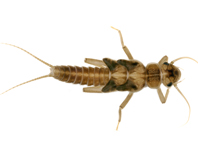Abstract
The new anchovy Stolephorus babarani n. sp. is described on the basis of 26 specimens collected from Panay Island, central Philippines. The new species closely resembles Stolephorus bataviensis Hardenberg 1933 and Stolephorus baweanensis Hardenberg 1933, all these species having a long upper jaw (posterior tip extending beyond posterior margin of preopercle), and numerous dusky spots on the suborbital area (in adults), snout and lower jaw tip. However, the new species differs from S. bataviensis by usually having the posterior tip of the depressed pelvic fin not reaching to vertical through the dorsal-fin origin (vs. extending beyond vertical through dorsal-fin origin), a shorter head (23.9–25.5% of standard length vs. 25.3–28.0%), and a greater distance between the dorsal-fin origin and pectoral-fin insertion (D–P1; 133.9–151.8% of head length vs. 109.9–136.3%). Stolephorus babarani is distinguished from S. baweanensis by having a shorter snout (3.6–3.9% of standard length vs. 3.8–4.6%). Moreover, the new species can be distinguished from S. bataviensis and S. baweanensis by higher gill raker counts on the first and second gill arches (16–18 + 21–23 and 10–13 + 18–21, respectively, vs. 14–17 + 19–22 and 9–12 + 17–20 in S. bataviensis and 14–17 + 19–22 and 9–12 + 17–21 in S. baweanensis). Stolephorus babarani is separated by 5.3% and 10.7% mean p-distances in the mitochondrial COI from S. baweanensis and S. bataviensis, respectively.
References
Conlu, P.V. (1986) Guide to Philippine Flora and Fauna. Vol. 9, Fishes. Natural Resources Management Center Ministry of Natural Resources, Manila and University of the Philippines, Manilla, 495 pp.
Hata, H. (2017) Stolephorus waitei Jordan & Seale, 1926. In: Motomura, H., Alama, U.B., Muto, N., Babaran, R.P. & Ishikawa, S. (Eds.), Commercial and Bycatch Market Fishes of Panay Island, Republic of the Philippines. The Kagoshima University Museum, Kagoshima, University of the Philippines Visayas, Iloilo, and Research Institute for Humanity and Nature, Kyoto, pp. 45.
Hata, H., Lavoué, S. & Motomura, H. (2019) Taxonomic status of seven nominal species of the anchovy genus Stolephorus described by Delsman (1931), Hardenberg (1933), and Dutt and Babu Rao (1959), with redescriptions of Stolephorus tri (Bleeker 1852) and Stolephorus waitei Jordan and Seale 1926 (Clupeiformes: Engraulidae). Ichthyological Research, 1–27. [published online: 10 June 2019]
https://doi.org/10.1007/s10228-019-00697-7
Hata, H. & Motomura, H. (2017a) A new species of anchovy, Encrasicholina auster (Clupeiformes: Engraulidae) from Fiji, southwestern Pacific Ocean. New Zealand Journal of Zoology, 44, 122–128.
https://doi.org/10.1080/03014223.2016.1268177
Hata, H. & Motomura, H. (2017b) First record of the anchovy Stolephorus teguhi (Engraulidae) from the Philippines. Philippine Journal of Systematic Biology, 11 (2), 20–24.
https://doi.org/10.26757/pjsb.2017b11017
Hata, H. & Motomura, H. (2018a) Stolephorus continentalis, a new anchovy from the northwestern South China Sea, and redescription of Stolephorus chinensis (Günther 1880) (Clupeiformes: Engraulidae). Ichthyological Research, 65, 374–382.
https://doi.org/10.1007/s10228-018-0621-z
Hata, H. & Motomura, H. (2018b) Stolephorus insignus, a new anchovy from the western Pacific and redescription of Stolephorus apiensis (Jordan and Seale 1906) (Clupeiformes: Engraulidae). Ichthyological Research, 66 (2), 280–288.
https://doi.org/10.1007/s10228-018-00675-5
Kimura, S., Hori, K. & Shibukawa, K. (2009) A new anchovy, Stolephorus teguhi (Clupeiformes: Engraulidae), from North Sulawesi, Indonesia. Ichthyological Research, 56, 292–295.
https://doi.org/10.1007/s10228-009-0103-4
Kumar, S., Stecher, G. & Tamura, K. (2016) MEGA7: Molecular Evolutionary Genetic Analysis Version 7.0 for Bigger Datasets. Molecular Biology and Evolution, 33, 1870–1874.
https://doi.org/10.1093/molbev/msw054
Motomura, H., Alama, U.B., Muto, N., Babaran, R.P. & Ishikawa, S. (Eds.) (2017) Commercial and Bycatch Market Fishes of Panay Island, Republic of the Philippines. The Kagoshima University Museum, Kagoshima, University of the Philippines Visayas, Iloilo, and Research Institute for Humanity and Nature, Kyoto, 246 pp.
Motomura, H. & Ishikawa, S. (Eds.) (2013) Fish Collection Building and Procedures Manual. English Edition. The Kagoshima University Museum, Kagoshima and the Research Institute for Humanity and Nature, Kyoto, 70 pp.
Rau, N. & Rau, A. (1980) Commercial Fishes of the Philippines. German Agency for Technical Cooperation, Eschborn, 623 pp.
Sabaj, M.H. (2019) Standard symbolic codes for institutional resource collections in herpetology and ichthyology: an online reference. Version 7.1 (21 March 2019). American Society of Ichthyologists and Herpetologists, Washington, D.C. Available from: http://www.asih.org (accessed 12 June 2019)
Silvestro, D. & Michalak, I. (2012) raxmlGUI: a graphical front-end for RAxML. Organisms Diversity & Evolution, 12, 335–337.
https://doi.org/10.1007/s13127-011-0056-0
Stamatakis, A. (2014) RAxML version 8: a tool for phylogenetic analysis and post-analysis of large phylogenies. Bioinformatics, 30, 1312–1313.
https://doi.org/10.1093/bioinformatics/btu033
Whitehead, P.J.P., Nelson, G.J. & Wongratana, T. (1988) FAO species catalogue Vol. 7. Clupeoid fishes of the world (suborder Clupeoidei). An annotated and illustrated catalogue of the herrings, sardines, pilchards, sprats, shads, anchovies and wolf-herrings. Part 2—Engraulidae. FAO Fisheries Synopsis, No. 125, i–viii + 305–579 pp.
Wongratana. T., Munroe, T.A. & Nizinski, M.S. (1999) Order Clupeiformes. Engraulidae. Anchovies. In: Carpenter, K.E. & Niem, V.H. (Eds.), FAO Species Identification Guide for Fishery Purposes. The Living Marine Resources of the Western Central Pacific. Vol. 3. Batoid Fishes, Chimaeras and Bony Fishes Part 1 (Elopidae to Linophrynidae). FAO, Rome, pp. 1698–1753.
Yabumoto, Y. (1988) Pleistocene clupeoid and engraulidid fishes from the Kokubu Group in Kagoshima Prefecture, Japan. Bulletin of Kitakyushu Museum of Natural History, 8, 55–74.

